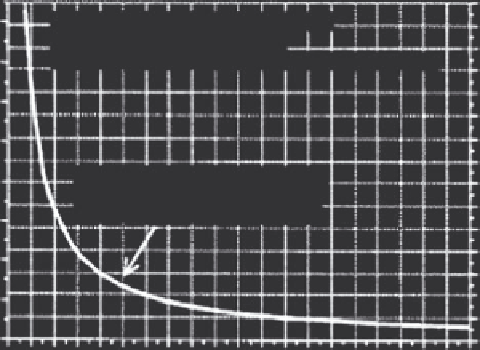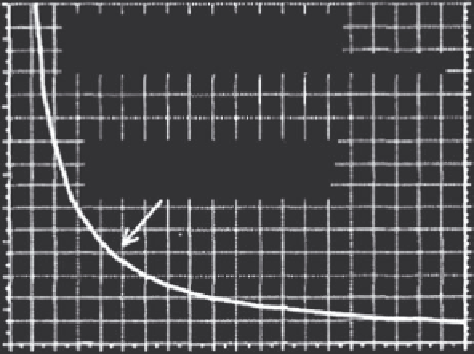Biomedical Engineering Reference
In-Depth Information
(
fH
a
) < 4.85 × 10
8
A/m-s. These approximate limits were verified
by Wust et al. through additional clinical study (Wust et al. 1991a;
Wust et al. 1991b) and were matched with early experimental fer-
rofluid heating data to demonstrate the promise of the field (Jordan
et al. 1993). These results are illustrated in Figure 17.1, which shows
expected power absorption for an experimentally characterized
ferrofluid, maintaining a 25 mW/ml inductive heating limit for a
representative torso (a) and cranium (b). This clinically determined
limit correlates well with that of Atkinson et al. Field combinations
above the curve will likely result in significant patient discomfort,
while operating below the limits should provide safe treatment.
Since tissue heating is proportional to the square of radius, it is
quite apparent that higher field limits are achievable for the case of
the cranium (noting that the ferrite concentration is 5 mg/ml for
the torso and only 1 mg/ml for the cranium). In both cases, sig-
nificantly higher ferrofluid heating can be achieved for higher field
strengths and frequencies less than approximately 500 kHz, with
optimal performance at around 100 kHz (Etheridge and Bischof
2012a) and so all subsequent discussions will focus on the physical
phenomena occurring in this lower frequency range.
17.2.3 activation of Iron Oxide Nanoparticles
in alternating Magnetic Fields
Detailed descriptions on the principles of magnetics and mag-
netic materials can be found in textbooks from Cullity (Cullity
and Graham 2009) and O'Handley (O'Handley 2000), and Gubin
has recently published a textbook focusing specifically on mag-
netism in nanoparticles (Gubin 2009). Briefly, however, mag-
netism arises at the atomic level from unpaired electron spins,
which behave like atomic dipole moments. Ferromagnetism is
the strongest form of magnetism and is due to strong exchange
(a)
15000
14000
13000
12000
11000
10000
9000
8000
7000
6000
5000
4000
3000
2000
Conductivity of tissue : 0.4 (mho/m)
Cross section diameter : 30 cm
Ferrite #P6-concentration : 5 mg/ml tumor volume
160
140
120
100
Inductive tissue load at
maximal radius r = 15 cm
25 mW/ml
80
60
40
20
1000
0
0
Frequency (kHz)
(b)
15000
14000
13000
12000
11000
10000
9000
8000
7000
6000
5000
4000
3000
2000
100
Conductivity of tissue : 0.4 (mho/m)
Cross section diameter : 20 cm
Ferrite #P6-concentration : 1 mg/ml tumor volume
90
80
70
60
Inductive tissue load at
maximal radius r = 10 cm
25 mW/ml
50
40
30
20
10
1000
0
0
Frequency (kHz)
FIGURE 17.1
Expected power absorption (based on experimental heating data) for 5 mg (a) or 1 mg (b) ferrite per ml tumor volume with an
inductive tissue load of 25 mW/ml at a maximum radius of 15 cm (a) or 10 cm (b), as a function of field frequency and magnetic field strength.
(From Wust, P. et al.
Strahlentherapie Und Onkologie,
166, 12, 1991a; Wust, P.,
Strahlentherapie Und Onkologie,
167, 3, 1991b.)


